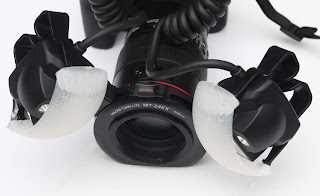MT24-EX
 |
| Canon MT24-EX twin macro flash |
One of the ways to ameliorate the harsh lighting from a single flash gun is to use two flashes so that one fills in the shadow caused by the other The Canon MT24-EX puts the two flash heads close to the subject on a cunning mounting ring and, consequently, allows for a small aperture at reasonable ISO. I have not been able to find figures for the flash duration, but the power can be adjusted from full to 1/64th.
Here is the same target I used for the previous article shot with my MT24EX. Again I used the Canon EOS R with a Canon 100mm F2.8L macro in manual focus mode with the focus set to 1:1. The exposure was F16 at 200 ISO with the shutter speed set to 1/200s (the fastest flash sync speed for the camera). The flash was set to manual mode and the exposure bracketed by setting the power in steps between 1/4 and 1/32 power.
 |
| MT24EX at 1/16 power |
|
|
Compared with a single flash, the shadows are much reduced, but the specular highlights are very obvious - although there are now two, one on either side of the thorax of the
Syrphus as well as the strong reflections from the wings. My feeling is that, compared to the YN560, this flash produces slightly warmer colours.
Just like the YN560 in the previous article, various plastic "diffusers" are available. These two were designed for the popup flashes on the top of cameras. I bought them a long time ago at a photo show (they were quite expensive!) because they happen to fit the MT24EX's flash heads reasonably well. The attachment is somewhat precarious and one of the arms got broken at some stage. It is held on now by the inevitable duct tape!
Here are the test target results:
 |
| MT24EX with plastic diffusers, 1/8 power |
|
|
Rather like the YN560's plastic cap, these plastic "diffusers" make very little difference. They absorb or scatter some light, so the exposure requires about a stop more light but, because the size of the flash heads has not changed, the quality of the lighting hasn't really altered. The specular highlights on the thorax and wings are pretty much unmodified.
To achieve more diffuse illumination requires some way of spreading out the area from which the light is coming. Some time ago, I had the idea of using a polystyrene bowl in front of the flash heads to spread the light and I actually bought a set of disposable party bowls from Tesco to try this out. But, how to attach it in front of the flash heads? The inspiration came from noticing that the MT24EX mounting ring has a 58mm filter thread. So, I thought of some sort of filter mount or stepping ring that would screw into this thread. Whilst searching for something suitable on
eBay, I came across a low profile lens hood which has three slots in the sides for just £4.95. I thought I could cut between these slots to leave just the base, but this turned out not to be necessary - the hood is low profile and does not get in the way at all and so could be used as is.
The external diameter of the hood is 61mm, so I cut a hole in the base of a bowl of this size. The thin polystyrene is tricky to cut, either using scissors or a craft knife. It has a tendency to splits. Wrapping the edges with thin strips of duct tape strengthened it and stopped the cracks spreading. It is also necessary to cut the lower side of the bowl flat so that it doesn't get in the way if you are trying to get low to the ground. Again, the cut needed reinforcing with narrow strips of duct tape. For my first attempt, I also cut off the rim of the bowl, but this turned out to be a mistake. Without it, the bowl became too weak and floppy.
 |
| MT24EX with polystyrene bowl diffuser fitted. |
An alternative would be to try expanded polystyrene bowls, which are probably a bit more rigid and certainly easier to cut accurately and cleanly. But I suspect that the light loss would be considerably greater since they are thicker, but probably worth the experiment. Anyway, here are the results shot using the bowl diffuser:
 |
| MT24EX with bowl diffuser, 1/4 power |
|
|
This has somewhat toned down the specular highlights and filled in the shadows and produced quite a pleasing image. I don't think this material has caused a noticeable colour shift. Possibly, the colours are a fraction warmer.
One of the advantages of the MT24EX is that it is very practical and convenient to use. The whole thing fits together easily and securely and it lacks the bulk of a setup based on a bigger flash gun like the YN560. The heads can be moved around the mounting ring and tilted up and down, so that it is very versatile, and the ratio of power between left and right can be adjusted to vary the modelling. The bowl diffuser also fits quite securely, doesn't get in the way or badly interrupt the view when trying to home in on a subject. I have found it to be a good setup in the field. Here are some examples taken in the garden using it.
 |
| Solitary bee Osmia bicornis |
 |
| Beefly Bombylius major |
 |
| Hoverfly Platycheirus scutatus - male |














